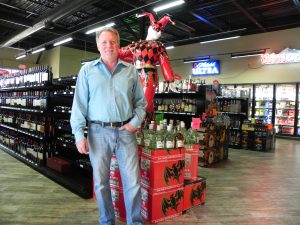Indy Bourbon experts explain Whiskey’s recent comeback
Writer / Cathy Wendorff / Photography Provided
 Deep with history and flavor, Bourbon’s recent comeback is ingrained into today’s culture. According to Bourbon enthusiast, Ray Cox, owner of Elite Beverages, “The Bourbon craze has been going on probably close to 10 years.”
Deep with history and flavor, Bourbon’s recent comeback is ingrained into today’s culture. According to Bourbon enthusiast, Ray Cox, owner of Elite Beverages, “The Bourbon craze has been going on probably close to 10 years.”
The movement began in the coastal states and is sweeping across the Midwest as more distilleries are popping up outside of its birthplace in Kentucky.
Cox explained that in the late 1700s after the Whiskey Rebellion, the distillers settled in Kentucky for three reasons — the limestone water, plentiful source of grains and to get as far away from the government’s taxation as possible. Recipes have been handed down through generations of distillers and perfected over the years to maximize flavor.
“There are many, many flavors to Bourbon,” Cox says. “It’s almost like fine wine, and you can kind of compare Bourbon’s rise in popularity to fine wine. But in Bourbon there are all kinds of flavors from mint to pepper, banana, floral notes, vanilla and carmel.”
He spoke about how there are many flavor profiles from the same distillers, due to the nuances of each barrel.
Because no one knows for sure, there are plenty of theories on how Bourbon came about. Basically, it is whiskey that can only be crafted in America with at least 51 percent corn in the mashbill of rye or wheat and malted barley. Aged in new oak barrels that are charred on the inside to maximize flavor over years, Bourbon becomes more enhanced the longer it stays in the barrel.
With roots connecting back to 1880, the Kentucky Distillers Association fought to protect the industry. In 1964, Congress declared Bourbon as America’s only native spirit because of the highly regulated aging process and specifications. Kentucky still produces 95 percent of the world’s supply of Bourbon and generated $8.5 billion in revenue and 17,500 jobs across the state last year, filling 1,886,821 barrels in contrast to the 455,078 back in 1999.
As Bourbon sales have fluctuated, so has the supply and demand.
“Thirty years ago you couldn’t give Bourbon away, there was a Bourbon Glut,” Cox says.
He credits pioneer distillers like Booker Noe and Bill Samuel’s for adapting their marketing techniques and promoting an older, smoother and more mixable product to appeal to women. Packaging became more creative as the red wax covering the Maker Mark’s bottle was invented to stand out on store shelves.
Growing up in Madison, Indiana across the river from Kentucky, Eric Prime is familiar with the rich history of Bourbon, too. He explained how Bourbon, which was once known as the Southern man’s drink, struggled from the 1970s through early 90s. Discussing the craft cocktail movement that started around 2005, where mixologists were creating a new version of throwback cocktails like Manhattans and Old-Fashions using Bourbon, “a lot of people attribute the resurgence of the cocktail culture to the resurgence of Bourbon,” Prime says.
Both Cox and Prime stated that a secondary sales market of scarce and highly sought after bottles also influenced the surge in popularity. With the help of social media and the internet, old bottles of Pappy Van Winkle are being sold to collectors in the range of $1,000 to $3,500, depending on the age. Also fueling the new trend in 1999 was the creation of the Kentucky Bourbon trail, which opened up distilleries for touring and tasting sessions.
Bourbon can be enjoyed in a variety of ways from neat, at room temperature or on the rocks to being mixed with coke or ginger ale. Many new restaurants and bars have recently opened up with a wide array of Bourbon choices. Mark Henrichs, owner of Revery and BaReV in downtown Greenwood, hand selects his own barrels of Bourbon to have bottled in his label for their signature cocktails. Cox also enjoys the process of selecting barrels to have bottled for his retail businesses, Elite Beverages. These types of selections are very popular with customers, which gives Cox a chance to educate the public with specific flavor profiles.
Whether or not Bourbon’s popularity has peaked, Cox predicts that it will continue to be a top choice moving forward.
“There is still a very strong demand in Japan, China and emerging markets,” Cox says. “Bourbon’s popularity will continue to be pretty good for the next few years.”
The Bourbon industry is banking that the trend will continue as women and millennials are discovering the American-made Whiskey. As with any consumption of alcohol, the Kentucky Distiller’s Association stresses the importance of drinking responsibly while sampling the history and flavor poured from each bottle.





